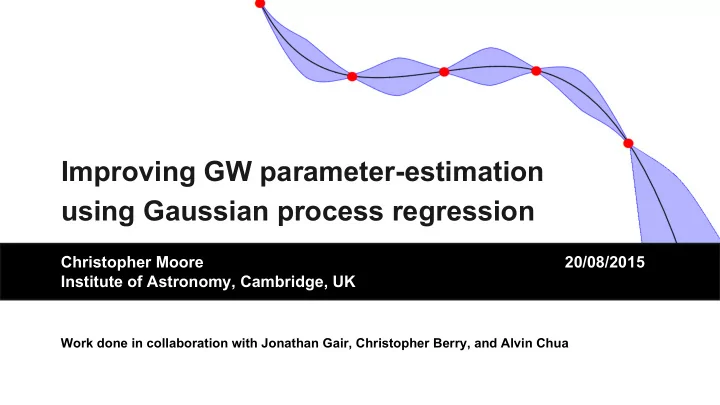

Improving GW parameter-estimation using Gaussian process regression Christopher Moore 20/08/2015 Institute of Astronomy, Cambridge, UK Work done in collaboration with Jonathan Gair, Christopher Berry, and Alvin Chua
1 Outline ● The problem with models ● The marginalised likelihood ● Implementation and results ● Summary
2 Data analysis preliminaries GW data assumed to consist of a signal and noise. The key ingredient in any Bayesian detection or parameter estimation study is the likelihood , But, we have to rely on approximate models.
3 The problems with models Two related problems with using approximate likelihood: ● Detection ; reduced evidence ● Parameter estimation ; shifted peak Our focus is on the parameter estimation problem Obvious solution is to develop better models! Accurate (but not completely accurate) waveform models do exist, but very computationally expensive for exploring high dimensional parameter spaces.
4 Outline ● The problem with models ● The marginalised likelihood ● Implementation and results ● Summary
5 Marginalised likelihood We propose the following alternative likelihood. This likelihood uses the full waveform model, but has marginalised over the unknown part. Two steps needed to evaluate this function: (i) specify the prior (ii) perform the integral. If the final likelihood is to be useful in an MCMC-type search, it must not be any slower than standard techniques. In particular, the integration must not slow down the evaluation. Moore & Gair (2014), PRL 113, 251101, arXiv:1412.3657
6 Specifying the prior: GPR The prior is formed by interpolating a set of waveform differences precomputed GPR is used for the interpolation. ● Non-parametric ● Training to learn properties ● Allows for analytic marg At some new point in parameter space, , GPR returns a Gaussian distribution for the waveform error at that point.
7 Performing the integral GPR returns a probability distribution for the waveform difference, which is a Gaussian. The Marginalised likelihood was defined by the following Gaussian integral. This may be evaluated analytically to give the following expression
8 The marginalised likelihood ● Shifts the likelihood into better agreement with the true parameters ● Broadens the posterior to reflect the level of confidence we have in the results ● Even in the limit of large signal strength (when systematic model errors normally dominate over random error) posterior is never inconsistent with true parameters ● The broadening of the posterior reduces the bias in parameter estimation Moore & Gair (2014), PRD 91, 124062, arXiv:1504.02767
9 Outline ● The problem with models ● The marginalised likelihood ● Implementation and results ● Summary
10 Implementation ● Choice of model waveforms: accurate model IMRPhenomC, approximate model TaylorF2 ● For simplicity, and to aid in developing new method, restrict to 1D interpolation in Chirp mass. (Symmetric mass ratio fixed to ~¼.) ● Two training sets were used with n=60 and n=120 points in range M c ∊ (5-5.6) M ⊙ ● A squared exponential covariance was found to perform best, with a typical length scale of ~0.01M ⊙
11 Results
12 Results
13 Results
14 Outline ● The problem with models ● The marginalised likelihood ● Implementation and results ● Summary
15 Summary ● Model errors are a known problem for advanced LIGO, particularly for high mass binary black hole systems. ● The marginalised likelihood (i) reduces the size of the error and (ii) properly accounts for any remaining error. ● In this paper we... ● Provided a detailed description of the marginalised likelihood for the first time ● Implement the method using approximants from LAL ● Explore the effects of different choices for the GPR training set and covariance function on the method ● Demonstrate that the marginalised likelihood works for binary black holes at realistic signal amplitudes Thank you for listening!
Recommend
More recommend